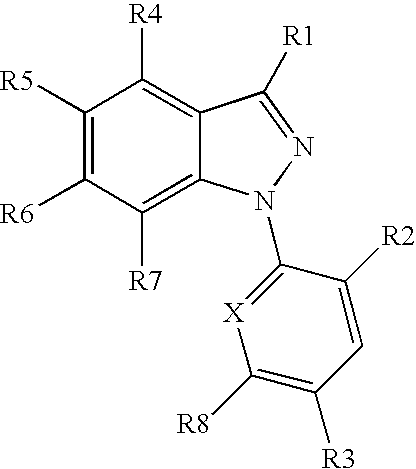Organophosphorus derivatives of indazoles and use thereof as medicinal products
a technology of organophosphorus and indazoles, which is applied in the field of new chemical compounds, can solve the problems of non-segregation of chromosomes, inability to tolerate patients, and inability to splice or disassemble spindles,
- Summary
- Abstract
- Description
- Claims
- Application Information
AI Technical Summary
Benefits of technology
Problems solved by technology
Method used
Image
Examples
example 1
Methylphenylphosphinic acid 3-((E)-styryl)-1H-indazol-5-yl ester
[0135]
[0136]A solution of 20 mg of 3-styryl-1H-indazol-5-ol, 5.76 mg of imidazole and 20.7 mg of methylphenylphosphinic chloride in 5 ml of dichloromethane is stirred at ambient temperature. After stirring for approximately one hour, 5.76 mg of imidazole and 20.7 mg of methylphenylphosphinic chloride are added. The suspension is stirred at ambient temperature for approximately 18 hours. 10 mg of imidazole and 70 mg of methylphenylphosphinic chloride are added. After 30 hours at ambient temperature, the reaction medium is treated with 10 ml of distilled water. The aqueous phase is extracted with 2×10 ml of dichloromethane. The organic phase is dried over magnesium sulfate and concentrated under reduced pressure in a rotary evaporator. The reaction crude is purified by preparative LC / MS to obtain 9.1 mg of methylphenylphosphinic acid 3-((E)-styryl)-1H-indazol-5-yl ester.
[0137]1H NMR spectrum (300 MHz, (CD3)2SO d6, δ in pp...
example 2
Diphenylphosphinic acid 3-((E)-styryl)-1H-indazol-5-yl ester
[0140]
[0141]A solution of 70 mg of 3-styryl-1H-indazol-5-ol, 300 mg of imidazole and of 273 μl of diphenylphosphinyl chloride in 15 ml of dichloromethane is stirred at ambient temperature. After stirring for approximately 90 minutes, the medium is treated with 30 ml of distilled water. The aqueous phase is extracted twice with 30 ml of dichloromethane and the organic phases are then dried over magnesium sulfate, filtered, and concentrated under reduced pressure on a rotary evaporator. The crude is taken up with ethyl acetate. The solid is filtered through sintered glass, and rinsed with ethyl ether. The filtrate is concentrated under reduced pressure in a rotary evaporator, and purified by flash chromatography on silica 35-70 μm. Eluent: cyclohexane / ethyl acetate gradient of 80:20 to 70:30. 143 mg of a yellow solid are collected. This compound is purified by preparative LC / MS to obtain 47.3 mg of diphenylphosphinic acid 3-(...
example 3
Methylphenylphosphinic acid 3-(1H-indol-2-yl)-1H-indazol-5-yl ester
[0145]
Procedure F:
[0146]A solution of 497 mg of 50%-pure methylphenylphosphinic acid 4-nitrophenyl ester in 8 ml of dichloromethane is stirred at ambient temperature. A suspension of 403 mg of 3-(1H-indol-2-yl)-1H-indazol-5-ol and 268 μl of 1,8-diazabicyclo[5.4.0]undec-7-ene in 12 ml of dichloromethane is added dropwise. The reaction medium is stirred at ambient temperature overnight and then evaporated to dryness under reduced pressure in a rotary evaporator. The reaction crude is purified by flash chromatography on a cartridge of 50 g of silica 15-35 μm. 300 mg of methylphenylphosphinic acid 3-(1H-indol-2-yl)-1H-indazol-5-yl ester are collected and recrystallized from ethyl acetate to obtain 220 mg of methylphenylphosphinic acid 3-(1H-indol-2-yl)-1H-indazol-5-yl ester.
[0147]1H NMR spectrum (300 MHz, (CD3)2SO d6, δ in ppm): 1.95 (d, J=14.5 Hz: 3H); 6.87 (broad s: 1H); 7.04 (split t, J=7.5 and 1 Hz: 1H); 7.13 (split ...
PUM
| Property | Measurement | Unit |
|---|---|---|
| wavelength range | aaaaa | aaaaa |
| flow rate | aaaaa | aaaaa |
| time | aaaaa | aaaaa |
Abstract
Description
Claims
Application Information
 Login to View More
Login to View More - R&D
- Intellectual Property
- Life Sciences
- Materials
- Tech Scout
- Unparalleled Data Quality
- Higher Quality Content
- 60% Fewer Hallucinations
Browse by: Latest US Patents, China's latest patents, Technical Efficacy Thesaurus, Application Domain, Technology Topic, Popular Technical Reports.
© 2025 PatSnap. All rights reserved.Legal|Privacy policy|Modern Slavery Act Transparency Statement|Sitemap|About US| Contact US: help@patsnap.com



